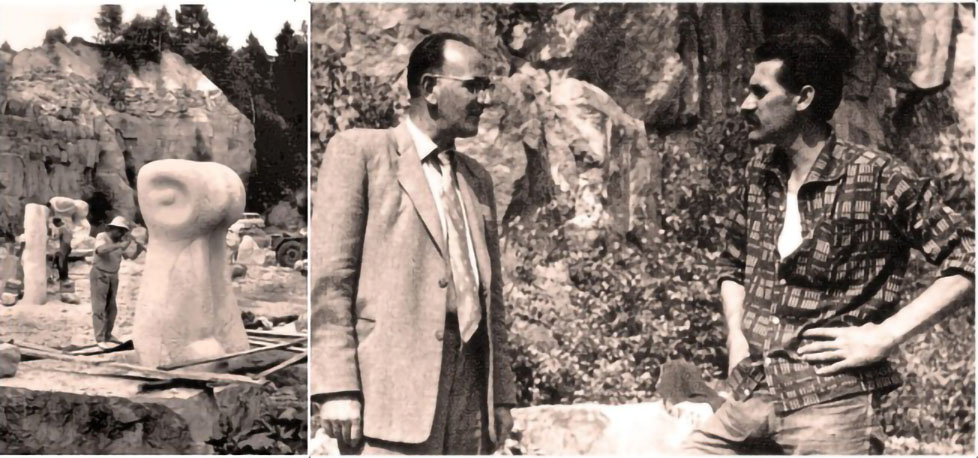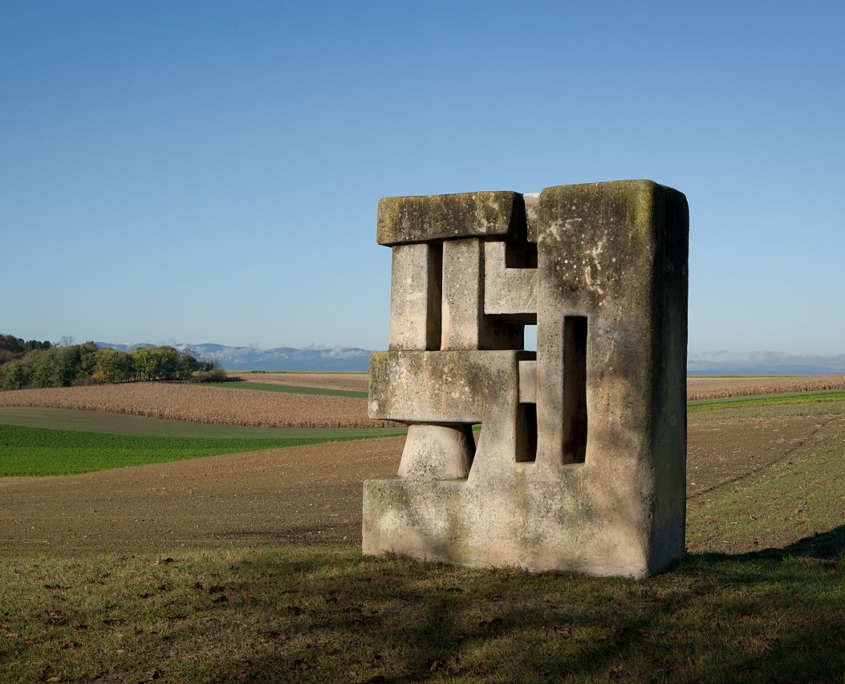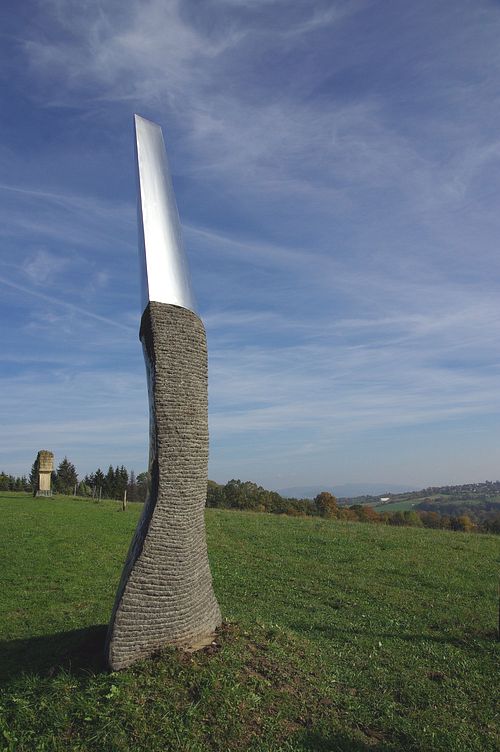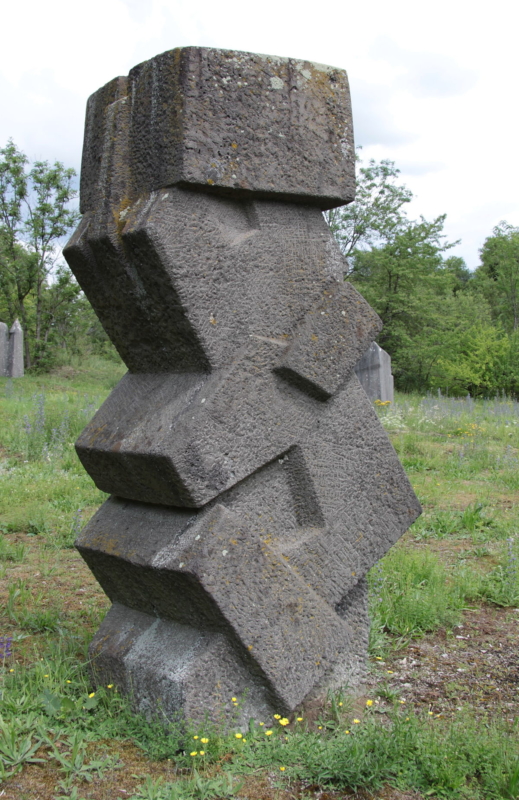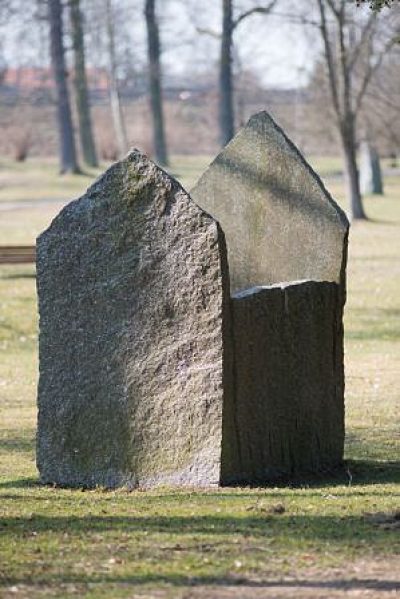Landek International Sculpture Symposiums
(History of the origin of the international sculpture symposiums in Europe)
Since 2002 the sculptor Martin Kuchař, the chairman of the Association for activities of international stone symposiums founded in 2001, has been organizing the Landek symposiums. He followed the previous 8 years of the International granite sculpture symposiums organized by the sculptor Josef Anderle in the towns of Milevsko and Jindřichův Hradec. Personally Martin Kuchař took part in the last symposium in 2000. These Granite sculpture symposiums followed the traditions of the international sculpture symposiums in Europe.
The first open air creative meeting was realized in 1959 in the village of Sankt Margarethen, Austria, in the area of the already closed limestone quarry founded by the Romans. „The father“ of this idea was a sculptor, teacher and later professor at Vienna Academy Karl Prantl.
At the beginning of the 1960s the idea of creative sculpture symposiums started spreading to other countries. Forma Viva, in former Yugoslavia, today´s Slovenia, has been the second and still continuously functioning international sculpture symposium since 1961. It was founded by Janez Lenassi and Jakob Savinšek. The project of Skulpturen Weg in Germany was the other sculpture symposium initiated by Leo Kornbrust, a sculptor and professor at Munich Academy.
Former Czechoslovakia was also one of the first European countries which had its own international sculpture symposium in the 1960s. It was in Hořice in Bohánečský quarry in Podkrkonoší area. Here the sculptor Vladimír Preclík initiated the foundation of the first sculpture park near the hill of St. Gothard. This oldest symposium has still been functioning for more than 50 years. In the second part of the 1960s the Czech sculptor Miroslav Chlupáč founded the international sculpture symposium in the spa town Vyšné Ružbachy pod Tatrami in Slovakia in the area of a closed travertin quarry. The symposium has not functioned for several decades.
The first sculpture symposiums followed the regulations in which the conditions for their acting were clearly stated. The foundation of sculpture parks, where the sculptures were properly marked – authorized, became its inseparable part.The idea of symposiums was not producing sculptures for their other sale but the enrichment and aestheticization of the public space. The first sculpture symposiums lasted at least for 4 weeks but also 8 weeks so that the artists could have enough time to complete their works.
The idea of international sculpture symposiums was spreading quickly to the whole world. Especially the Japenese, Koreans, Swedes were very successful. Today a big amount of symposiums are found in China and Turkey. These countries invest a lot of money to art in public space. The old good Europe has been running out of breath and the art in public space has not been its principal topic any more.
The present sculpture symposiums in European countries often last only for 14 days, sometimes only a few days… They have become a sort of sculpture sprints. Also the purpose of many sculpture symposiums have moved away from the original ideas and conception of their founders. The quality of works is often low and many of these fast produced sculpture works do not cultivate the public space but spoil the general taste of the non-professional public.
The Landek international sculpture symposiums have respected their founders´original ideas since 2002, the first year of their functioning. Sculpture parks were founded but they had to be moved twice from the area of the Hornické Museum near the hill of Landek to Těrlicko Hradiště in Horní Dvůr. From there after the notice to quit from the land owners they had to be moved for the second time to another new place of 100 years old cemetery in Těrlicko Hradiště near Babí Mountain. After many difficult adjustments carried by the village of Těrlicko the place became a new home for the sculpture park which is daily open to the public.
Since 2002 the Landek symposiums had taken place as biennials in the area of the Hornické Museum in Ostrava Petřkovice. The last 5th event took place there in 2010. In that year the OKD company, which owned the museum and supported it all the time, transferred the flourishing site to the Vítkovice company. It was an unexpected manoeuvre that the former miners, who initiated and developed the museum, only hardly understood. The new owner of the museum Ing. Jan Světlík, CEO was not interested in following this successful project and tradition of the Landek international sculpture symposiums. The organizer of the symposium the sculptor Martin Kuchař had lived and worked in the museum for 10 years together with other artists during Landek symposiums. After the worsening of renting conditions he decided to interupt the tradition of Landek symposiums for some time and left the Hornické Museum. He moved to his new atelier in his newly built house in the village of Vělopolí where he also placed the seat of the Association for activities of international stone symposiums.
During solving the problem with moving the sculpture park from Horní Dvůr near Babí Mountain in Těrlicko the Association started to cooperate with the village of Těrlicko and concluded the contract on renting the sculptures in the sculpture park near Babí Mountain for 30 years. The cooperation has successfully been going on this year on the common project, i.e. the organizing of the next Landek symposiums – 6th Těrlicko – Landek 2019 international sculpture symposium which takes part from 10th August to 7th September in Těrlicko close to the football stadium. The sculpture park will be completed with new sculptures which will also trim the path leading from the local basic school.


